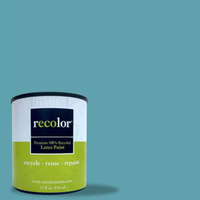It’s important to remedy these anxieties (you could try learning some relaxation tips for sleep (opens in new tab)) in order to stay as well rested as possible, and one great way of rethinking your slumber space is to give it a make-over with one of the best bedroom wall colors for sleep. According to the National Sleep Foundation (opens in new tab), the color of your bedroom walls can have an effect on your restful state due to how your eyes process different shades. Retinal ganglion cells (RGC), a type of neuron located near the inner surface of the retina of your eye, are responsible for sending information to the part of your brain that controls your body’s 24-hour rhythm (circadian rhythm), which affects your performance, sleep and more. Colors that are recognized as more soothing can help reduce your heart rate and blood pressure and therefore contribute to a more peaceful snooze. Certain colors are processed as more or less relaxing by these cells, so if you really want to maximize the peacefulness of your bedroom, you’ll want to pay close attention to the tone of your walls.
The best bedroom wall colors for sleep
Regarding the question of which particular shade is best to aid sleep, blue is the standout winner for a few reasons. A study by hotel chain Travelodge (opens in new tab) found that people sleeping in a blue room slept for seven hours and 52 minutes per night on average, which was the longest recorded sleep in any of the colored rooms tested. They also found that 58% of respondents with a blue bedroom reported they ‘regularly wake up feeling happy’. The brain associates the color blue with feelings of relaxation and calm, which are ideal sleep conditions for a busy mind. It’s also the main color we generally recognize when we think of things that calm us: oceans, and wide-open natural spaces. If you can use your walls as a canvas to transport yourself mentally to a calmer place, then your sleep will surely benefit. Admittedly, blue as a bedroom wall shade won’t be for everyone style-wise. But keeping your colors cool-toned, with grays and silvers, will still help have an effect on lowering your blood pressure and heart rate. If the idea of neutral-toned walls gives off less warmth than you can envisage in your bedroom, then worry not. Other relaxing shades can be found in pastel colors like pale yellow, which has enough sunshine to be warming but is not so bright that it over-stimulates your mind just as you want to power down. Rather than focusing on coolness, pastel colors can foster feelings of warmth in your bedroom and create an inviting atmosphere to help you burrow down at night. As we discuss in our why is sleep important (opens in new tab) feature, the right bedroom environment is vital for good sleep.
Are there any bedroom walls colors to avoid?
If your aim is to relax your brain before you drift off, it might be wise to avoid starkly bright colors in the room you sleep in, like neon pink, yellow, or green. Travelodge’s study found that the color purple held deep associations with creativity and was great for sparking the imagination. So while that shade might be great for an office or studio, in a bedroom it could lead to higher levels of alertness. That makes purple a shade not so conducive to a great night’s sleep and therefore one to steer clear of. Extremely dark shades, such as black or brown, may be great for keeping a room as dark as possible when you’re sleeping but aren’t likely to promote a good wake-up routine. Rather than being enveloped in darkness, it’s important to keep yourself in tandem with the natural rhythms of the sun. One way to keep a consistent level of light year-round and promote a restful wake-up is with one of the best sunrise alarm clocks (opens in new tab), which mimic the effects of natural sunlight in the mornings. They work to gradually get your body accustomed to the start of the day, which means no more waking up with a jolt. So, now that you know which bedroom wall colors aid better sleep, here are three slumber-friendly shades to consider:
How can I keep injecting personality into my bedroom with color?
If you’re a person who likes to use their bedroom walls as a canvas for how they feel, then the idea of pastel-toned decor may be unattractive. Thankfully, there are still lots of great ways to keep your bedroom exciting and fresh with color. One of these could be to maximize the brightness of artwork on the walls, so you can break up whichever relaxing hue you’ve picked with your favorite prints. For more help visualizing how exactly you want your room to come together, check out our guide to the best interior design software (opens in new tab). Alternatively, you can always add a splash of color to your room in smaller doses. This could be behind your headboard, or on the wall your bed is balanced against. Opting for a bright or patterned feature wall in those places would allow your creative energy to manifest in your bedroom, without the risk of it ruining your precious sleep time, as it’s out of your line of sight. For more inspiration on how to keep your rooms looking happy, check out our feature on how to add color to your home (opens in new tab).



